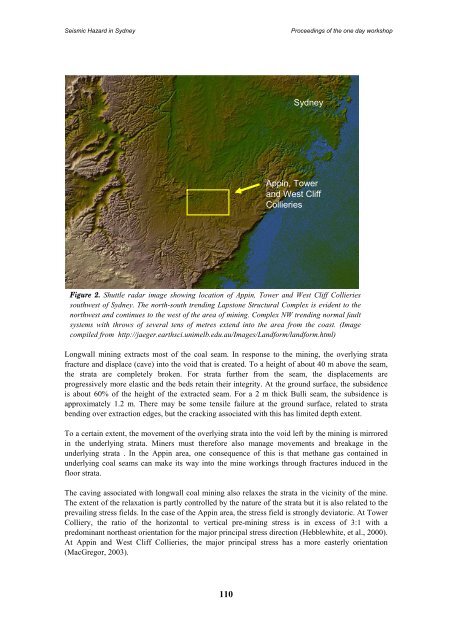Landslides in the Sydney Basin - Geoscience Australia
Landslides in the Sydney Basin - Geoscience Australia
Landslides in the Sydney Basin - Geoscience Australia
- No tags were found...
Create successful ePaper yourself
Turn your PDF publications into a flip-book with our unique Google optimized e-Paper software.
Seismic Hazard <strong>in</strong> <strong>Sydney</strong>Proceed<strong>in</strong>gs of <strong>the</strong> one day workshop<strong>Sydney</strong>App<strong>in</strong>, Towerand West CliffCollieriesFigure 2. Shuttle radar image show<strong>in</strong>g location of App<strong>in</strong>, Tower and West Cliff Collieriessouthwest of <strong>Sydney</strong>. The north-south trend<strong>in</strong>g Lapstone Structural Complex is evident to <strong>the</strong>northwest and cont<strong>in</strong>ues to <strong>the</strong> west of <strong>the</strong> area of m<strong>in</strong><strong>in</strong>g. Complex NW trend<strong>in</strong>g normal faultsystems with throws of several tens of metres extend <strong>in</strong>to <strong>the</strong> area from <strong>the</strong> coast. (Imagecompiled from http://jaeger.earthsci.unimelb.edu.au/Images/Landform/landform.html)Longwall m<strong>in</strong><strong>in</strong>g extracts most of <strong>the</strong> coal seam. In response to <strong>the</strong> m<strong>in</strong><strong>in</strong>g, <strong>the</strong> overly<strong>in</strong>g stratafracture and displace (cave) <strong>in</strong>to <strong>the</strong> void that is created. To a height of about 40 m above <strong>the</strong> seam,<strong>the</strong> strata are completely broken. For strata fur<strong>the</strong>r from <strong>the</strong> seam, <strong>the</strong> displacements areprogressively more elastic and <strong>the</strong> beds reta<strong>in</strong> <strong>the</strong>ir <strong>in</strong>tegrity. At <strong>the</strong> ground surface, <strong>the</strong> subsidenceis about 60% of <strong>the</strong> height of <strong>the</strong> extracted seam. For a 2 m thick Bulli seam, <strong>the</strong> subsidence isapproximately 1.2 m. There may be some tensile failure at <strong>the</strong> ground surface, related to stratabend<strong>in</strong>g over extraction edges, but <strong>the</strong> crack<strong>in</strong>g associated with this has limited depth extent.To a certa<strong>in</strong> extent, <strong>the</strong> movement of <strong>the</strong> overly<strong>in</strong>g strata <strong>in</strong>to <strong>the</strong> void left by <strong>the</strong> m<strong>in</strong><strong>in</strong>g is mirrored<strong>in</strong> <strong>the</strong> underly<strong>in</strong>g strata. M<strong>in</strong>ers must <strong>the</strong>refore also manage movements and breakage <strong>in</strong> <strong>the</strong>underly<strong>in</strong>g strata . In <strong>the</strong> App<strong>in</strong> area, one consequence of this is that methane gas conta<strong>in</strong>ed <strong>in</strong>underly<strong>in</strong>g coal seams can make its way <strong>in</strong>to <strong>the</strong> m<strong>in</strong>e work<strong>in</strong>gs through fractures <strong>in</strong>duced <strong>in</strong> <strong>the</strong>floor strata.The cav<strong>in</strong>g associated with longwall coal m<strong>in</strong><strong>in</strong>g also relaxes <strong>the</strong> strata <strong>in</strong> <strong>the</strong> vic<strong>in</strong>ity of <strong>the</strong> m<strong>in</strong>e.The extent of <strong>the</strong> relaxation is partly controlled by <strong>the</strong> nature of <strong>the</strong> strata but it is also related to <strong>the</strong>prevail<strong>in</strong>g stress fields. In <strong>the</strong> case of <strong>the</strong> App<strong>in</strong> area, <strong>the</strong> stress field is strongly deviatoric. At TowerColliery, <strong>the</strong> ratio of <strong>the</strong> horizontal to vertical pre-m<strong>in</strong><strong>in</strong>g stress is <strong>in</strong> excess of 3:1 with apredom<strong>in</strong>ant nor<strong>the</strong>ast orientation for <strong>the</strong> major pr<strong>in</strong>cipal stress direction (Hebblewhite, et al., 2000).At App<strong>in</strong> and West Cliff Collieries, <strong>the</strong> major pr<strong>in</strong>cipal stress has a more easterly orientation(MacGregor, 2003).110
















